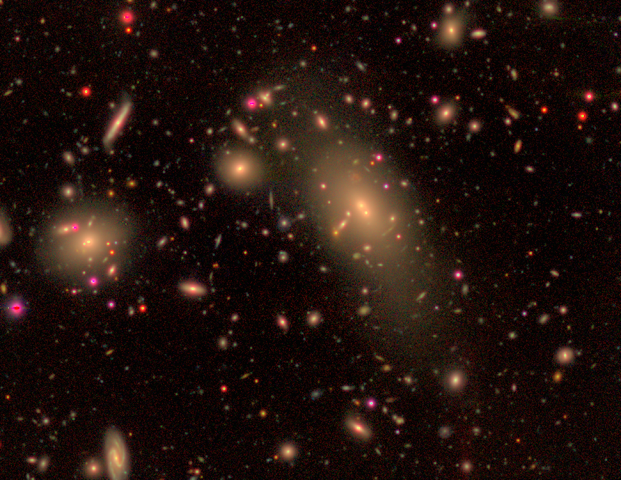Brightest Cluster Galaxies
Contact

University of California, Santa Cruz
Princeton University
Summary
This program targets BCGs (brightest cluster galaxies) not part of the main MaNGA sample. These BCGs are selected from the Yang et al. 2007 group catalog. The BCGs targeted here are brighter and in more massive halos than BCGs already in the MaNGA main sample, but many studies will likely use the ancillary BCGs with BCGs from the primary and secondary samples.
Finding Targets
An object whose MANGA_TARGET3 or MNGTARG3 value includes one or more of the bitmasks in the following table was targeted for spectroscopy as part of this ancillary target program. See SDSS bitmasks to learn how to use these values to identify objects in this ancillary target program.
| Program (bit name) | Bit number | Target Description | Target Density (deg-2) |
|---|---|---|---|
| BCG | 17 | Brightest Cluster Galaxies | 0.03 |
Description
Brightest cluster galaxies (BCGs) have long been recognized as a distinct class of galaxies. BCGs include the most luminous and largest galaxies in the universe, residing in the highest density regions. Because BCGs typically lie at the centers of massive dark matter halos, they are ideal systems for examining the connections between galaxy structure and dark matter halos. MaNGA will observe signatures of BCG assembly, such as stellar population gradients and lowered central dark matter fractions. Combining MaNGA observations with weak lensing imaging data, particularly from the HyperSuprimeCam on Subaru, we will explore the connections between these signatures and dark matter halo properties.
Luminous BCGs are rare and many low-z BCGs in the SDSS footprint are currently absent from the MaNGA target catalog, particularly bright BCGs (Mr < -23) in the most massive halos (Mh > 1014 Msun). This ancillary program targets 50 such BCGs, prioritizing those in halos the most massive halos. We are using the Yang et al. friends-of-friends group catalog to select brightest cluster galaxies. Some of our science goals will use observations of individual galaxies from this sample, such as connecting weak lensing of massive clusters to the kinematics of their BCGs. However, we plan to use this BCG sample in conjunction with BCGs selected from the MaNGA primary sample, as this is a representative sample of BCGs in clusters with halo masses between 13.75 < log Mh/Msun < 14.5.
Target Selection
While there are several samples of central galaxies in the literature, building an uncontaminated sample of central galaxies spanning a range of halo masses is non-trivial. Different cluster finders and central galaxy selections, automated and visual, often disagree. We base our target selection on the Yang et al. 2007 (Y07) cluster catalog, created from the SDSS DR7 NYU VAGC (Blanton et al. 2005), a spectroscopic galaxy catalog.
Y07 use an iterative, adaptive group finder to assign galaxies to halos. We are using their modelC catalog, which uses the SDSS model magnitudes and includes redshifts from SDSS and 2dF and nearest neighbors from the VAGC. Our starting point is to identify central galaxies as the most luminous (in r-band) galaxy. This is noted in the catalog file imodelC_1. We also note the group halo mass based on the total luminosity ranking of the groups, which is in the modelC_group file in the Y07 catalog. More details about how the groups are selected and halo masses assigned are in Y07. To build our sample, we apply the following cuts to this catalog:
- grp_f_edge > 0.6
- 0.04 < zgroup < 0.15
REFERENCES
Blanton, M.R., et al. 2005, AJ, 129, 2562
Yang, X., et al. 2007, ApJ, 671, 153


